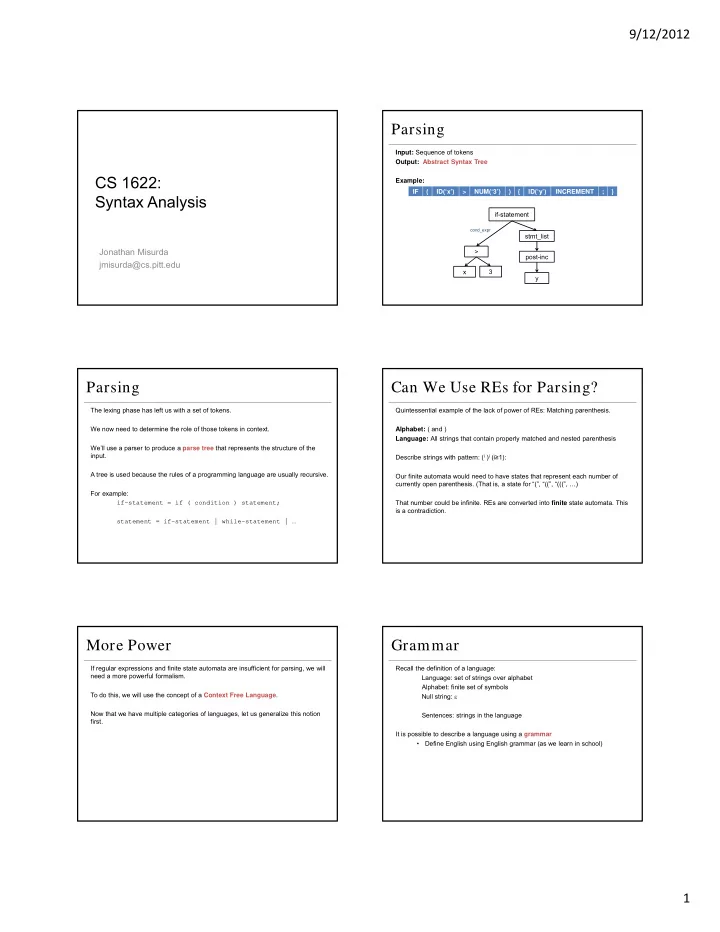

9/12/2012 Parsing Input: Sequence of tokens Output: Abstract Syntax Tree CS 1622: Example: IF ( ID(‘x’) > NUM(‘3’) ) { ID(‘y’) INCREMENT ; } Syntax Analysis if-statement cond_expr stmt_list Jonathan Misurda > post-inc jmisurda@cs.pitt.edu 3 x y Parsing Can We Use REs for Parsing? The lexing phase has left us with a set of tokens. Quintessential example of the lack of power of REs: Matching parenthesis. We now need to determine the role of those tokens in context. Alphabet: ( and ) Language: All strings that contain properly matched and nested parenthesis We’ll use a parser to produce a parse tree that represents the structure of the Describe strings with pattern: ( i ) i (i ≥ 1): input. A tree is used because the rules of a programming language are usually recursive. Our finite automata would need to have states that represent each number of currently open parenthesis. (That is, a state for “(”, “((”, “(((”, …) For example: if-statement = if ( condition ) statement; That number could be infinite. REs are converted into finite state automata. This is a contradiction. statement = if-statement | while-statement | … More Power Grammar If regular expressions and finite state automata are insufficient for parsing, we will Recall the definition of a language: need a more powerful formalism. Language: set of strings over alphabet Alphabet: finite set of symbols To do this, we will use the concept of a Context Free Language . Null string: Now that we have multiple categories of languages, let us generalize this notion Sentences: strings in the language first. It is possible to describe a language using a grammar • Define English using English grammar (as we learn in school) 1
9/12/2012 Grammars Derivation A grammar consists of 4 components (T, N, s, ): “LHS → RHS” • Replace LHS with RHS T — set of terminal symbols • Specifies how to transform one string to another • Essentially tokens — appear in the input string � ⇒ � : string derives N — set of non-terminal symbols • � ⇒ � — 1 step ∗ • Categories of strings impose hierarchical language structure • � ⇒ � — 0 or more steps • Useful for analysis. Examples: declaration, statement, loop, ... � • � ⇒ � — 1 or more steps s — a special non-terminal start symbol that denotes every sentence is derivable from it — a set of production rules: “LHS → RHS”: left-hand-side produces right-hand-side Example Chomsky Hierarchy of Languages Language L = { any string with “00” at the end } ( /0{2}$/ ) A classification of languages based on the form of grammar rules • Classify not based on how complex the language is 1 Grammar G = (T, N, s, ) • Classify based on how complex the grammar (the describe the language) is T = {0, 1} 0 0 N = {A, B} A B C s = A Four types of grammars: = { A → 0A | 1 A | 0 B, 0 • Type 0 — recursive grammar B → 0 • Type 1 — context sensitive grammar } • Type 2 — context free grammar • Type 3 — regular grammar Derivation : from grammar to language • A ⇒ 0A ⇒ 00B ⇒ 000 • A ⇒ 1A ⇒ 10B ⇒ 100 • A ⇒ 0A ⇒ 00A ⇒ 000B ⇒ 0000 • A ⇒ 0A ⇒ 01A ⇒ ... Regular Languages Context Free Languages Form of rules: Form of rules: A → A → or A → B where A N, (N T) + A can be replaced by at any time. where A,B N, T Proper CFLs have no “erase rule” where a production is replaced by . Regular grammars define REs. • If there are rules deriving empty string, rewrite to remove empty rule (Such as in Chomsky Normal Form) Example: A → 1A Example: A → 0 S → SS S → ( S ) S → 2
9/12/2012 Context Sensitive Languages Unrestricted/ Recursive Languages Form of rules: Form of rules: A → → where A N + ; (N T); (N T) + ; |A| ≤ | | where (N T) + , (N T) * Replace A by only if found in the context of and The erase rule is allowed. No erase rule. No restrictions on form of grammar rules. Example: Example: aAB → aCB aAB → aCD aAB → aB A → Are CFGs enough for PLs? Are CFGs enough for PLs? We’ve determined that because of nesting and recursive relationships in The CFG allows for the following derivations: programming languages that REs (type 3 grammars) are insufficient. S ⇒ DU ⇒ int x; x=0; S ⇒ DU ⇒ int x; y=0; What about Context Free (type 2) grammars? S ⇒ DU ⇒ int y; x=0; S ⇒ DU ⇒ int x; y=0; Imagine we want to describe the grammar of valid C or Java programs that have the declaration of a variable before their use: You would need a Context Sensitive grammar (type 1) to match the definition to the use. S → DU D → int identifier; So why do we seem to want to use CFGs? U → identifier ‘=’ expr; • Some PL constructs are context free: If-stmt, declaration • Many are not: def-before-use, matching formal/actual parameters, etc. • We’ll like CFGs because they are powerful and easily understood. • But we’ll need to add the checks that CFGs miss in later phases of the compiler. Language Classification Summary Regular Grammar ⊆ CFG ⊆ CSG ⊆ Recursive Grammar 3
Recommend
More recommend